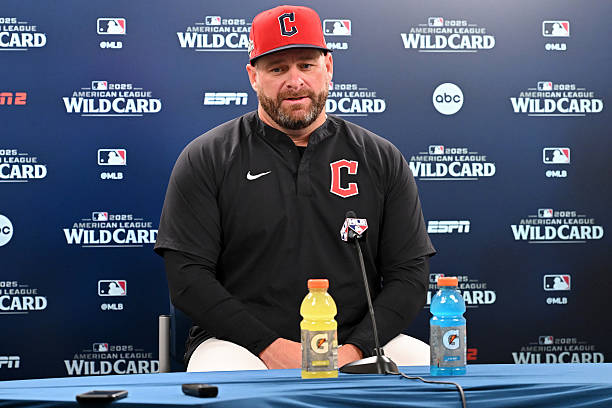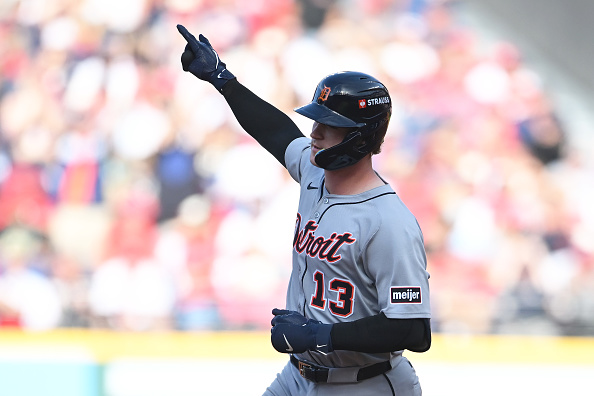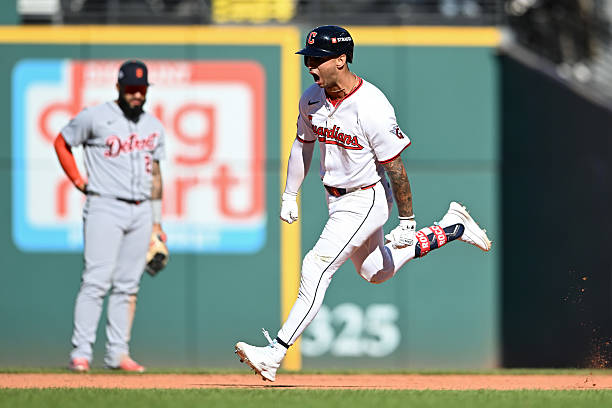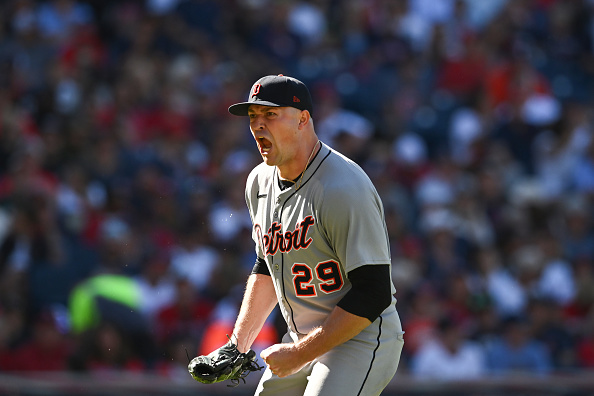GOODYEAR, Az. — Jose Ramirez hit his first home run of the spring and had three RBI on Wednesday to help the Cleveland Guardians defeat Team Mexico, 6-0.
Ramirez wanted to play for his native Dominican Republic in this year’s World Baseball Classic. The all-star third baseman had thumb surgery a few months ago and decided it was better to remain in the Cleveland camp and work his way back than to try and go full-bore in the WBC and risk any injury.
Mexico, which produced one of Cleveland’s most memorable players 70 years ago in Bobby Avila, used the warmup for WBC play later this week at Chase Field in Phoenix.
Amed Rosario hit a one-out single off Houston Astros right-hander Jose Urquidy in the first inning, stole second, and continued to third when catcher Austin Barnes threw wildly. Ramirez then roped a 3-2 pitch over the wall in right.
Cleveland starter Zach Plesac allowed one double and two walks over four sharp innings against a Mexican team comprised predominantly of MLB veterans. James Karinchak, Trevor Stephan, Nick Sandlin, Enyel De Los Santos and Michael Kelly worked one scoreless inning apiece.
Rookie Gabriel Arias touched Urquidy for his first homer and 3-0 lead in the second. In the fifth, Myles Straw doubled, scored on a double by Rosario, who scored on yet another double by Ramirez. Steven Kwan and Will Brennan also doubled among Cleveland’s 11 hits. Bryan Rocchio added an RBI single.
Lefty Jaime Arias, who pitched for Guardians farm teams the past two years, worked 2/3 of an inning and Colorado Rockies shortstop Alan Trejo had three hits for Mexico, which opens WBC play Saturday against Colombia, managed by former Cleveland infielder Jolbert Cabrera.
Mexican Legend Bobby Avila
This is an updated version of my article written in August 2004, when Cleveland celebrated the 50th anniversary of winning 111 games and the American League pennant. Avila died of complications from diabetes in his native Mexico shortly thereafter on Oct. 27, 2004.
Embed from Getty Images
Baseball certainly has changed since Bobby Avila hit .341 for Cleveland to win the 1954 AL batting title. The Cleveland Guardians were the Indians. There was no World Baseball Classic though most assuredly he would have been proud to represent his homeland in such a competition.
More importantly to Avila, the standard of living in his native Mexico improved dramatically after he entered politics there shortly after concluding a fine 11-year career in the majors. He is proud of his records in baseball but even prouder of his work in office.
“I really have not followed baseball at all the last few years,” said Avila, 80, when he was in Cleveland in 2004. “The reason I don’t follow baseball now is I have been very busy with politics. I was the mayor of my hometown of Veracruz twice and went to Congress twice as a senator. I retired from politics three years ago. Forty years was enough.”
“Politics was a 24-hour job, so I did not follow baseball that much. I only went (to) the Veracruz games, I did not follow the Indians or other American teams. Veracruz is a very important city and we have made it a good place to live, with good industry and a good way of life.”
El Presidente?
Avila often was mentioned as a candidate to become president of Mexico, but never ran for the office. He was a respected figure who advised those in office in his homeland for years.
“Respect is one of the most important things a person can have,” Avila said. “I was one of the first Latin players, but I never had any trouble in American baseball. That is because I treated everybody with respect. That is a lesson that applies to everyone throughout the world today. Respect others and they will respect you.”
Though he did not follow baseball intensively, Avila was well aware of the financial structure of the sport.
“As an old ballplayer, I am glad to see the big salaries because it is good for the ballplayers,” he said. “But I do think it is hurting the game. Because of the salaries, too many people cannot come to a ballgame. How much does it cost a family? If you have just one kid with you, how much? So a lot of people cannot come to watch. Money has changed the game a lot.”
Unbelievable Money
Embed from Getty Images
“In our days, we made what was good money, but when I see the money today it is unbelievable. When I was in Cleveland for a game in the first year of this ballpark (1994), people asked how much money I would make today. I told them, ‘You see that second baseman there on the other team hitting .250 and making $10 million?’ So they said, how much would they have to pay you. I said, ‘If I played today you’d have to give me this stadium.’ ”
Avila was joking, though he was the Roberto Alomar of his day — a swift second baseman with great range in the field as well as an accomplished hitter who averaged over .300 for a six-year (1950-55) span during the height of his career.
Cleveland owner Bill Veeck purchased his contract for $17,500 out of the Mexican League. An adept bunter and daring baserunner, his background as a soccer player often paid off when he would intentionally kick the ball out of an opposing infielder’s glove while sliding. Cleveland had the great Joe Gordon playing second base. Avila made his big-league debut on April 30, 1949, in Detroit against right-hander Virgil Trucks in a 7-5 loss. He was sent to the minors and got only 14 at-bats in the majors that season.
Mexican Marvels
He was the fourth native of Mexico to play in the majors and remains one of the finest. Mel Almada was the first for the Boston Red Sox in 1933. The quick outfielder batted .284 in 646 games over seven seasons for four teams. He paved the way for 144 others thus far, including some names fans in Cleveland will fondly recall: Jorge Orta, Oliver Perez, Vicente Romo, Karim Garcia, Horacio Pina, Sid Monge, Andres Mora, and others. Mora had only 18 at-bats for Cleveland after hitting 27 homers over parts of three seasons in Baltimore. In the Mexican League, he remains a legend. He crashed 419 homers there.
Avila began to split time with Gordon at the position in 1950 and batted .299 in 80 games. Gordon retired and Avila took over in 1951, hitting .304 with 10 homers.
Though he was never considered a power hitter and totaled only 80 homers in his career, Avila did have a career day on June 20, 1951, when he hit three homers, a double, and a single as he went 5-for-6 in a 14-8 win over the Red Sox in Boston. His 15 total bases were a Cleveland record until Rocky Colavito slugged four homers on June 10, 1959, in Baltimore. Avila finished 10th in voting for the MVP Award in the AL in 1951, then made the All-Star team for the first time in 1952, when he hit .300, scored 102 runs, and led the league with 11 triples.
Avila’s Breakout Leads to His Best Season for Cleveland
After another good season in 1953, came his big year of 1954, when he led the league with a .341 average, scored 112 runs, had career highs of 15 homers and 67 RBI, and finished third in the MVP voting. He went 3-for-3 and drove in two runs in the 1954 All-Star Game at Cleveland Stadium and had his average as high as .396 in June. No Cleveland player has won a batting title since Avila that year.
“Oh, it was the best year of my career and the best year for the team, too,” he said. “It could have been a lot better for both of us, too. We could have won the World Series and who knows what I might have done if I didn’t get hurt.
“I hurt my finger in a game, actually broke it. They took me to the hospital and put a wrap on it, but I kept playing anyway. Sometimes, it made it difficult to hold the bat properly. I was up near .400 before the injury, but because of the finger there were some pitches I just couldn’t handle. But I wanted to play.”
Cleveland’s Dynamic Duo
Avila particularly enjoyed batting second behind speedy Al Smith and was saddened to hear that his old partner had passed away in January 2002. “He was one of my very favorite teammates,” Avila said. “He was a good man and a good baseball player. We worked so well together, especially on one play where we had a special sign. We loved to do that play.
“When he would get on first base, I would give him a look. He knew. Then I would bunt and make the third baseman come in. Well, Al, he was so fast that he would already be near second. The third baseman would try to throw me out at first, but Al would just keep going to third. When I beat out the bunt, we had runners on first and third and nobody out. That set things up for the big hitters, Larry Doby and Al Rosen.”
Avila scored 112 runs and Smith 101 (in 74 fewer at-bats), while Rosen had 102 RBI and Doby drove in 126 that year.
Avila Lit up the Bases
Avila could run, too. He stole 78 bases overall in an era when base stealing was ignored, especially in the homer-happy AL. Boston’s Dom DiMaggio led the AL in steals in 1950 with 15. Avila’s career-best 17 steals in 1956 were only four behind league leader Luis Aparicio of Chicago.
“I loved to run the bases,” recalled Avila, who by 2004 spent much time in a wheelchair. “I remember one game at old Cleveland Stadium against Boston where I was running. Ted Williams was in left field and I was on first. Rosen got a base hit to left. Williams knew he had no chance to throw me out at third base, so he just threw it to second to keep Rosen from moving up, too. I just kept running and went all the way home from first base on a single.
“You have to play that way, think about the game, put pressure on the team. There was more than one time I scored from second on a sacrifice fly. You had to do it when it counts. I didn’t want to do it when we were ahead by 10 runs or losing by 10. They never let me run on my own because the guys behind me, Rosen and Doby, would hit home runs. If it was a close game, then the manager, Al Lopez, would say to run and give it a try.”
1954: Great Yet Disappointing
Avila’s fondest memories are of that 1954 season. His bitterest recollections are from the World Series that year.
“Every player in baseball, their goal is to get to the World Series,” he said. “It is the most important thing and we got there, so we were proud. But baseball is a funny game. We lost at least three or four pennants to the Yankees during those years. It wasn’t because they beat us, it was because how they beat the other teams.
“We used to play every other team 22 times. One year, the Yankees beat Washington 21 of 22. You know how many we lost to Washington? Fourteen. That was the difference. To win pennants you have to beat the lousy teams and then you divide the rest with the good teams.”
The 1954 Indians destroyed the bottom three teams, going 18-4 against the Washington Senators, 19-3 vs. the Baltimore Orioles and 18-4 vs. the Philadelphia Athletics.
1954 World Series Game One, Game On
Game One of the 1954 World Series started so well for Cleveland at the Polo Grounds in New York. Smith was hit by a pitch by Sal Maglie, a tough veteran known for intimidating hitters. Avila followed with a single and Smith, of course, went to third. Two outs later, both scored on a triple to right-center by Vic Wertz.
Embed from Getty Images
The Giants tied it, 2-2, in the third inning off Bob Lemon. Cleveland appeared to be in position to go ahead in the eighth when Doby walked and took second on a single by Rosen. Left-hander Don Liddle was summoned from the bullpen to face the lefty-swinging Wertz and everybody expected a bunt. The big first baseman tried to lay one down on a 1-1 pitch, but fouled it.
Wertz then launched a long fly ball to center, where Willie Mays, knowing that Liddle was a groundball pitcher, had moved in to potentially field a ground single and throw home to cut off the runner. Instead, Mays had to turn and run full speed for the ball. The catch has been replayed thousands of times and is considered by many the greatest catch in history, given the circumstances.
Not by Avila.
“Willie was a great ballplayer, no question about it,” he said. “But I don’t think he made a good play. The Polo Grounds’ centerfield was the key. It was 500-some feet to the wall there (actually 483), which gave him room to run, but Willie started one way and the ball went the other. Watch the replay. He had to turn and circle around to get it. He made a great play on something that should have been an easy out. If it was Joe DiMaggio, he would have been standing there to catch it.”
DiMaggio Defense
Embed from Getty Images
Avila believes DiMaggio was the greatest player he ever saw. “It depends on what you are asking,” he said. “If you are asking about hitting, then it is Ted Williams. For all-around playing baseball, it is DiMaggio.
“DiMaggio never made an error. Willie used to get balls in centerfield and make these long throws, but never got anybody out. DiMaggio would make the catch and throw people out afterwards, too. On that play, Willie just turned and made a bad throw. DiMaggio would not have done that. He was a better centerfielder. He was the best.”
The score of that crucial World Series game remained tied and went to extra innings, where Avila believes Cleveland should have won. Wertz, who went 4-for-5 that day, with the only out being his 460-foot flyball caught by Mays, led off the 10th with a double. Rudy Regalado ran for him and was bunted over to third by Sam Dente. Dave Pope was walked intentionally and Bill Glynn batted for Jim Hegan but struck out.
“That brought up Bob Lemon and he was a real good hitter,” Avila recalled of the Hall of Fame pitcher who began his career as a third baseman and hit 37 career homers. “Lemon hit a ball so hard, I can still see how it was going, straight towards right field. A certain double with one run, maybe two scoring. But the first baseman, Whitey Lockman, made a little dive and got it.”
That Was A Home Run?
Embed from Getty Images
Then came the heart-breaking bottom of the 10th for the Indians and Avila said he never forgot it. Mays drew a one-out walk and stole second. Hank Thompson was intentionally walked and Dusty Rhodes pinch hit for Hall of Famer Monte Irvin. Rhodes, a .253 career hitter, had a magical season in 1954, belting 15 of his 54 career homers with a .341 average in only 164 at-bats, mostly as a pinch-hitter.
“That was a home run?” Avila said. “Rhodes hit that ball to right field. Well, I am the second baseman and turned around because I thought I had a chance to get it. It was a pop fly. Our right fielder, Davey Pope, was against the wall and there was nothing he could do. It just fell from the sky and into the first row of the stands and the game was over.”
A three-run homer hit all of maybe 260 feet, since the right-field wall was 258 feet from home plate. After Wertz had hit one nearly twice as far and was out, it was tough to take.
“That’s the way things go in baseball sometimes,” Avila said. “Except for those plays in the World Series, I have a lot of good memories of Cleveland. But after that season, things started to go down. A few years later, the general manager, Frank Lane, started trading everybody away. It was not fun.”
One Last Pennant Race
Bobby Avila was traded to Baltimore before the 1959 season but played only 20 games for the Orioles. He went to the Red Sox for 22 games, then to the Milwaukee Braves, involved in a pennant race with the Los Angeles Dodgers.
Embed from Getty Images“I was excited to go there because they had great players like Hank Aaron and Eddie Mathews,” he said of the Braves, who had won the NL pennant in 1957 and 1958. “I hit a home run my first game.”
The two-run shot in the ninth inning gave Milwaukee a 5-4 win over Cincinnati on July 22. That win was huge, since the Braves and Dodgers ended up tied for the pennant.
“You know how we lost?” said Avila. “In a playoff. Two games and we lost them both by one run.” Milwaukee lost, 3-2 and 6-5. That final game, on Sept. 29, 1959, was Avila’s last in the majors.
Embed from Getty Images
Avila still ranks in the top five in every offensive category except strikeouts among all Mexicans in MLB history. He played in three All-Star games, second only to the great pitcher Fernando Valenzuela and more than slugger Vinny Castilla (320 homers, 1,105 RBI, 2 ASG).
He moved back to Mexico, became owner of a ballclub, and eventually president of the Mexican League before entering politics. “I have had a good life,” he said. “And I had a good time in Cleveland. It is my second home.”
NEXT: The Guardians play host to the San Diego Padres on Thursday.
More Cleveland Guardians Articles
More MLB Articles
Main Photo:
Embed from Getty Images
- Category
-
Cleveland Guardians






That was a GREAT story, Chuck. I knew the name “Bobby Avila”, but I didn’t know anything about the player or the man. Now I wish I could have seen him play.
His critique of Mays’ catch of Wertz’ blast at the Polo Grounds was funny 😎. That’s the first time I’ve seen/heard anybody describe it with anything less than effusive praise.
I also had no idea that he almost hit .400 (before getting injured) in a season. Clearly, Bobby Avila was one of the greats. Love stories like this one.